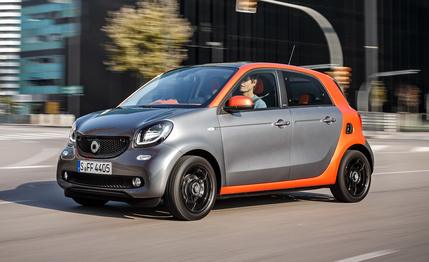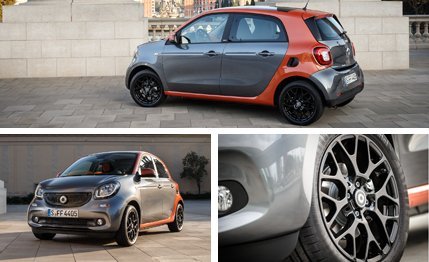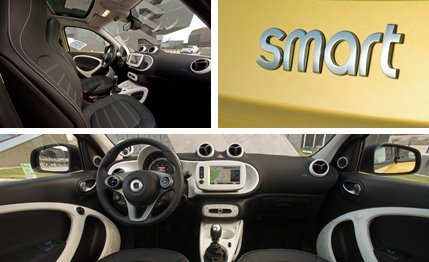 First Drive Review
First Drive Review
The Smart Fortwo is a known quantity. It’s the expensive novelty you often see strewn haphazardly on snippets of unclaimed urban streetscape, especially in Europe. It survives because of Daimler stubbornness—after 16 years, the automaker has yet to boast of a Smart profit—and burbles along at about 100,000 global sales per year, partly because it’s the only thing of its kind. The new Fortwo arrives here next year as a 2016 model.
The Forfour is a different story. You might not have heard of the four-door, four-seat Forfour before. It’s the Fortwo’s big brother, born of the same alliance with Renault. It shares its skeleton with the Renault Twingo, its five-speed stick and six-speed dual-clutch gearboxes with the Twingo, its two three-cylinder engines with the Twingo. It’s even built by Renault in Slovenia.
For all its research, Smart has no genuine idea how many of these will sell. It could produce a sales boom, giving Fortwo owners with kids somewhere more practical to go. It could just as easily be a bust, because that’s what happened the last time the brand made a Forfour. Yes, Smart has been down this road before, with a rebodied Mitsubishi Colt built in the Netherlands and launched in 2004 to such overwhelming apathy that it was killed after just two years.
But unlike the previous (and very cynical) Forfour, this one has some brand-typical stuff in it, like rear-drive, the same pair of three-hole engines sitting in the back, the same suspension, and the same gearboxes as the new Fortwo. It loses some Fortwo stuff, though, with the dent-resistant plastic door skins giving way to old-school, Renault-friendly pressed sheetmetal.
It’s also in the odd position of being considerably longer (31.5 inches) than the old Fortwo, at 137.6 inches yet able to turn a tighter circle. That tight, roughly 28-foot turning circle is just one city trick the Forfour has to offer. Others include rear doors that open at 85 degrees and a quirky folding action on the rear seats that give it a surprisingly useful luggage area.

But it will almost certainly never come to the U.S. Here’s where it gets tricky: In Germany, this car is only €660 (approximately $820) more expensive than the Fortwo. Value, right? Wrong. The Smart Fortwo is expensive, but it also has its segment almost to itself. Adding two doors to it for a minor markup doesn’t make it a bigger, cheaper Smart; it makes it yet another of dozens of micro players in Europe—and one that’s a lesser car than cheaper offerings from Hyundai (the i10) and Skoda (the Citigo), to name just two.
Which brings us to America, where cars like the i10 and the Citigo have zero chance of ever being sold, but that doesn’t mean the Forfour would be without competitors here: namely its own brother. The Fortwo and the Scion iQ are the only U.S.-market cars small enough to be in the same segment as the Forfour—even the Chevy Spark is 7 inches longer, the Ford Fiesta 22 inches longer. Its potential for cannibalizing Smart’s own sales—such as they are—is the reason the four-door is not coming here.
But is that a shame or not? In the U.S. context, it just might be. Most urban parking areas in the States aren’t so small that there’s a desperate need for the Fortwo, so the extra practicality of the Forfour makes sense. It’s also a better car.
The view from the front seats is identical to the Fortwo’s, down to the 6.5-inch multimedia touch screen and the cute air vents. LED daytime running lights are standard, as are cruise control, a speed limiter, power windows, and active seatbelt tensioners. There is an available multifunction steering wheel, a 3.5-inch TFT screen in the instrument cluster, a JBL sound system with a 240-watt amplifier, and an app that allows a smartphone to be connected directly to the car’s systems.

But the commonalities belie the fact that this is a much more mature package on the road. The Forfour carries a claimed 88 additional pounds of sound deadening than the Renault on which it is based, putting the curb weight somewhere around 2300 pounds, but the car performs miracles when traversing broken roads. The five-door Smart rides very well for a car this size, partly because of the tall-sidewall tires and partly because the extra wheelbase versus the Fortwo reduces the pitching that dogs that model under braking.
It also handles with a lot more civility. Even though its narrow tires mean it will never cut hot laps, it’s composed and assured and easy to wield. The stability control is an infrequent presence, and the noise levels from the three-cylinder turbo engine are low, too. Even the gutless 1.0-liter three-cylinder is quieter and feels better sorted here, displaying less of a tendency to surge in the heavier car.
But it’s not fast. The, um, sprint to 62 mph takes more than a second longer than it does in the Fortwo version with a commensurate engine. The three-cylinder, available in 70-hp 1.0-liter naturally aspirated and 89-hp 0.9-liter turbocharged variations, is also not technically sophisticated. Consider that the Smart’s engines are port-injected in a world where Ford is now selling a high-tech direct-injected turbo three.
As for the Forfour’s additional accommodations, it’s easy to get in and out of the back seats. Adults can sit back there for short trips with no significant complaints, and, as we mentioned, the rear seats now mean that families might actually stop into a Smart dealer. One demerit: The rear cargo room is slightly compromised versus the Fortwo’s, as you lose 2.6 cubic feet of space with the rear seats in their locked and upright positions.
So it’s a better Smart. We’re as unsure as its maker whether the Forfour will translate to sales success, and we’ll get by just fine without it on our shores, but that doesn’t mean we wouldn’t have liked to see how the U.S. would have factored into the equation.